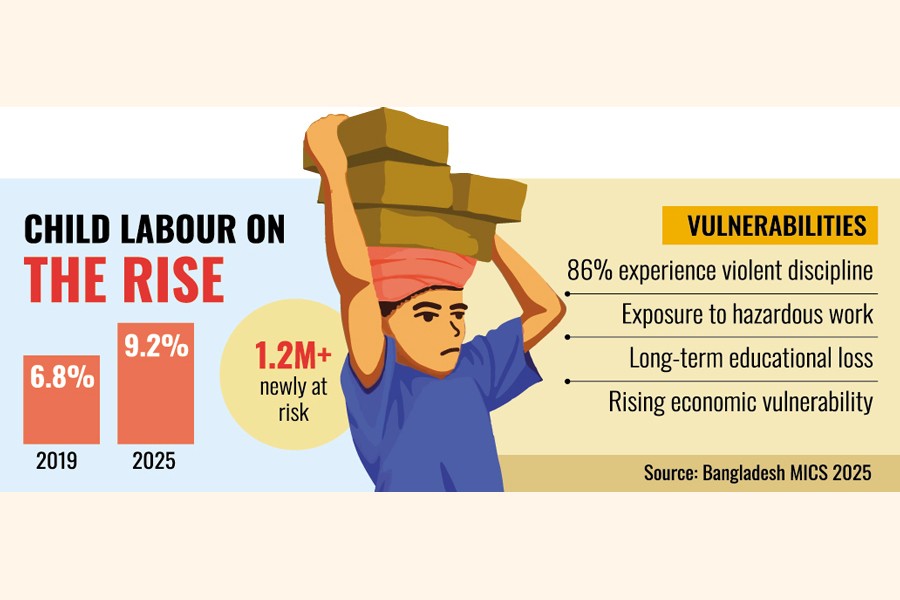
Published :
Updated :

Bangladesh is witnessing a sharp rise in child labour, with 9.2 per cent of children aged 5-17 now engaged in work, up from 6.8 per cent in 2019, putting an additional 1.2 million children at risk of exploitation, hazardous work, and long-term setbacks, according to the preliminary findings of the Bangladesh Multiple Indicator Cluster Survey (MICS) 2025.
The survey by the Bangladesh Bureau of Statistics (BBS) painted a troubling picture of declining child health, protection, and overall development, while also flagging setbacks in water and sanitation, health, education, and other key human-development indicators, particularly for children and women.
The findings were unveiled at the Bangladesh-China Friendship Conference Centre in the capital on Sunday.
The event, chaired by BBS Director General Mohammed Mizanur Rahman, was arranged with the support of the United Nations Children's Fund (UNICEF).
Aleya Akter, secretary of the Statistics and Informatics Division (SID); Rana Flowers, UNICEF representative to Bangladesh; economists; experts; and development workers spoke at the event.
The experts warned that the rise in child labour, combined with persistent violence, posed long-term threats to their safety and wellbeing.
The report said 86 per cent of children experience violent discipline.
Toxic lead exposure has emerged as one of the most pressing threats to children's health, revealed the report, while nearly four out of 10 children aged 12-59 months have blood lead levels above safe limits, with Dhaka particularly affected at 65 per cent.
Pregnant women are also at risk, with 8 per cent showing unsafe lead levels.
UNICEF officials warned that lead contamination could permanently damage brain development, affecting children across all income groups.
Malnutrition indicators also paint a grim picture, while wasting increased from 9.8 per cent in 2019 to 12.9 per cent in 2025.
Maternal anaemia remains high at 52.8 per cent.
Adolescent births have risen from 83 to 92 per 1,000 girls, and early initiation of breastfeeding has fallen to 30 per cent, highlighting gaps in maternal and child nutrition.
The survey also showed sharp rises in medical interventions, with caesarean section deliveries climbing to 51.8 per cent in 2025 from 36 per cent in 2019.
Meanwhile, access to early antenatal care remains low, with only 46 per cent of women receiving care in the first four months of pregnancy.
Contraceptive prevalence has also declined, from 62.7 per cent to 58.2 per cent.
Child protection and legal identity remain critical concerns, while only 59 per cent of children under five are registered and just 47 per cent have birth certificates.
Child marriage has declined marginally to 47 per cent but still affects nearly half of girls before the age of 18.
Water and sanitation conditions have worsened despite improvements in some areas.
Safely managed drinking water has fallen to 39.3 per cent, with half of water sources and more than 80 per cent of household water contaminated with E coli.
Climate-related hazards impacted over 10 per cent of water sources last year, while only 60 per cent of households have functional handwashing facilities with soap and water.
Education outcomes remain uneven. While primary enrolment is 80 per cent, attendance drops sharply in higher grades, and many children complete primary school without mastering the basic reading or numeracy skills. About 6-7 per cent of children remain out of school.
Experts said the findings highlighted urgent gaps in child protection, health, nutrition, water safety, and learning.
They stressed that immediate and targeted investments were needed to prevent further deterioration and ensure that all children could grow up safe, healthy, and educated.
BBS and UNICEF officials said based on nearly 63,000 households, MICS 2025 provided vital data to guide policies and programmes, showing progress and persistent challenges affecting children's health, nutrition, protection, and development.
The survey covered 172 standard and 27 SDG indicators, aligned with national priorities and global standards.
It provided estimates for all divisions, districts, and three city corporations, helping policymakers target inequalities, officials said.
The MICS 2025 came at a critical time for Bangladesh and was a reflection of both progress and the ongoing challenges, said Rana Flowers.
"While declines in child marriage and child mortality show what is possible, crises like lead poisoning and child labour are depriving millions of children of potential, and rising caesarean rates threaten women's health," she said.
Aleya Akter noted that the MICS survey was more relevant than ever, given its expanded scope to include new modules, such as anaemia testing and heavy metal exposure assessments among pregnant women and young children.
jahid.rn@gmail.com


 For all latest news, follow The Financial Express Google News channel.
For all latest news, follow The Financial Express Google News channel.